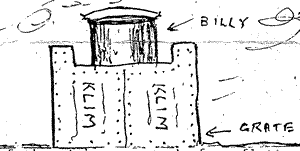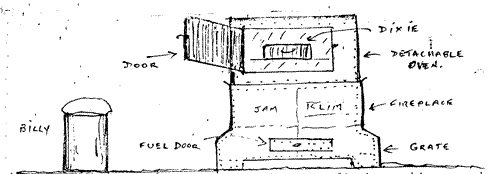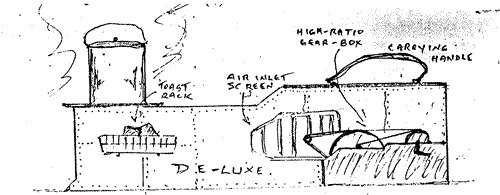Prisoners of War
Cooking Behind Barbed Wire: The Evolution of Prison Camp Cookers
Below is a reprint of an article written by John Frizell (ex-POW) and donated to us by John Parfitt. We have not been able to track down either the author or the publication in which it might have appeared, or even determine if it was ever published. We would welcome any information anyone may have on this.
The ingenuity of people placed in distressed situations has proved, over the years, that many basic problems can be overcome. Such was the case among World War 2 prisoners of war, when faced with the problem of cooking whatever meagre rations came their way.
The following chronicle of the evolution of prison camp cookers as observed by the writer between 1942 and 1945, might be of interest to members and might also point towards a solution of our country's energy conservation problems.
Stage 1
First observed and practised by the writer in the infamous Benghazi P.O.W. cage, about August, 1942.

Simply an empty jam or meat can on a couple of bricks fuelled by anything that would burn. The rations at Benghazi were such that a quite small can was sufficient for the purpose.
Stage 2
The advent of "tin-tapping".

The first of the tin stoves, made from flattened-out tins from British Red Cross parcels, lap-jointed and riveted with a metal punch, to form a receptacle for a "billy" or Dixie (if you still had one). This was better than the old brick fireplace, but rather smoky and heavy on fuel. These were first seen in Northern Italian P.O.W. camps after the arrival of precious food parcels through the British Red Cross.
Stage 3
The "up-market" tin fireplace.

This was the acme of fireplaces, with grate, firebox, chimney and detachable oven. Many "tasty" dishes, concocted from dubious ingrediences (sic), were baked in such devices as these. The oven was smoke-proof and efficient but fuel was always the problem (apart from that of finding anything worth baking).
Stage 4
The advent of the pneumatic power source.

This was believed to be the brain-child of a Pommy sailor, the first of the famous "blowers". Made simply from a couple of "KLIM"([Canadian] milk powder) tins, a fish can – remember the old "goldfish?" and a bit of canvas material, to form the bellows. Compact, quick, portable, smokeless and burning only a bit of charcoal; these could be used inside the huts and at night-time, after the huts were locked, became an unrecognised menace to health by the production of copious quantities of carbon monoxide. Those of us who had nothing to cook were prompted to cry: "where did those bastards get that food?" and "blowers to the s….house".
Stage 5
The two-cylinder blower.

A refinement of the original blower; simple in theory and twice as quick in its action. Two pumps provided a constant flow of air into the fire-box; this was a very efficient and economical system of quick boiling and cooking.
Stage 6
At last – fan power!

Red Cross tins, a nail or two and someone's cut up belt driving a metal bladed fan, the machine provided a "forced" air supply to a clay lined fire-box, enabling remarkably quick brewing with only a few sticks of wood or charcoal as fuel. Very efficient and economical.
Stage 7
Of course, a deluxe model!

The ultimate in blowers – streamlined, super-fast, smokeless and with a definite "art-nouveau" aesthetic quality. This was the tin-tapper's masterpiece, but. Like most high profile products, somewhat expensive for the average "kreigie" when the currency was either cigarettes, coffee, soap, sugar or other precious items from Red Cross parcels.
The efficiency of these gadgets as they evolved, became quite remarkable. Present-day T.V. advertisements claim that the latest electric kettle can boil a cup of water in thirty seconds. Any P.O.W. "blower" worth its salt, fifty years ago, would boil a quart billy in that time or less, fuelled by only handful of charcoal.
"Blower" races became a popular sport in some camps, with front runners usually being heavily backed on the side, in cigarettes. There were usually two divisions on the program: (a) starting up and brewing from ignition (matches were scarce) and (b) the sprint, with billy being put on a fully fired blower. The races were, of course, brief, but quite spirited.
When most of us in the northern Italian camps were "black-birded" by the Germans after Italy's collapse in September 1943, a number of blowers made the journey to Germany, but the writer does not recall whether much use was made of them in the Reich: our German hosts seemed unsympathetic to such activities such as "tin-tapping" by the occupants of the smaller "arbeits kommandos" or working camps. However some sophisticated blowers were developed in the large base "Stalags". In fact, the smaller, portable versions proved invaluable during the long, bitter death march to the west, which began in January 1945, as the Russian forces pressed in from the east. But that's another story.
Illustrations by the author, from war-time sketches – not to scale and not conforming to any other artistic convention either!
Next: Interview - Camp Entertainment >